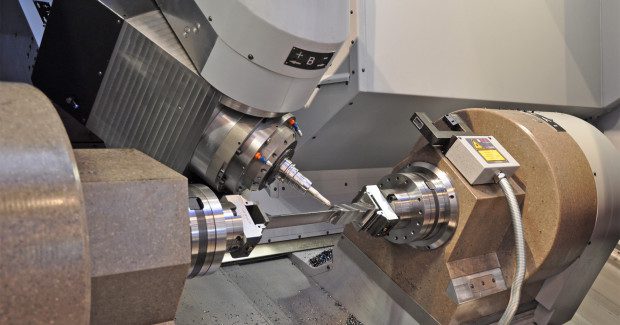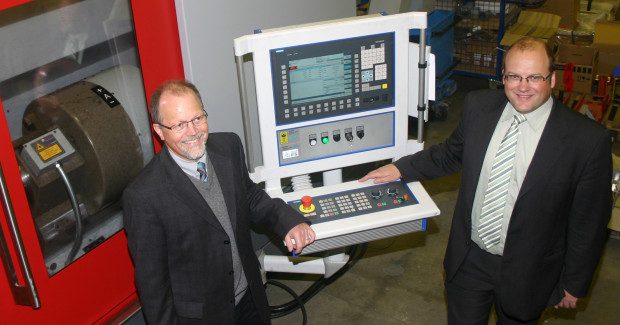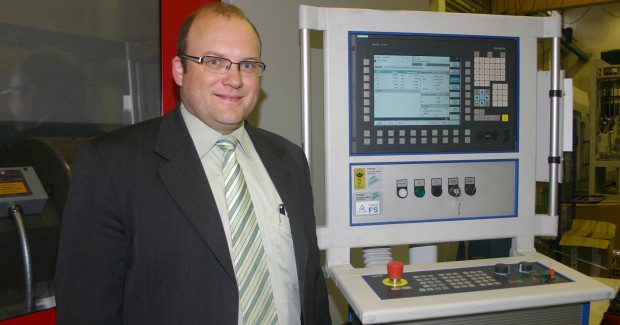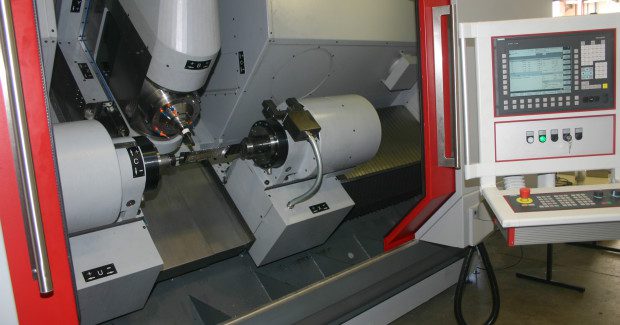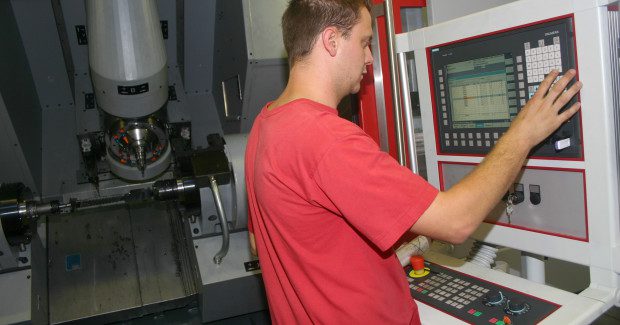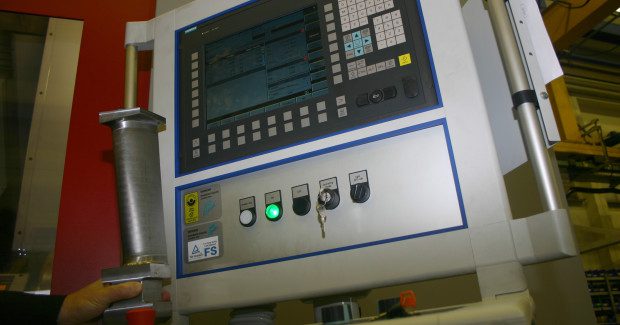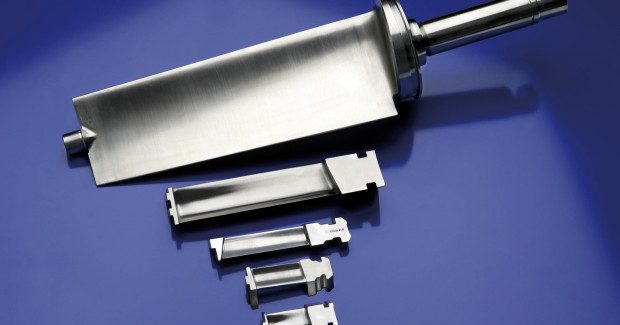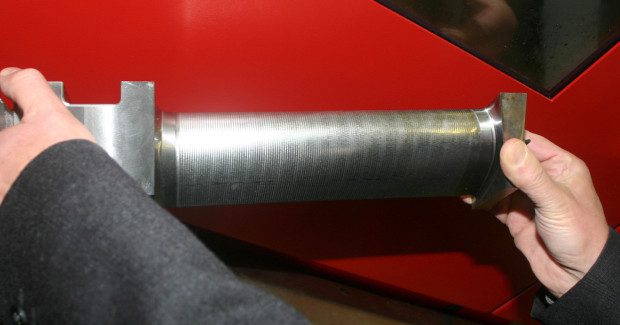Producing Turbine Blades with the Highest Precision
This shop shows how to strike an ideal balance between the powerful roughing and ultra-precise finishing that is required to make turbine blades by building a five-axis turn-mill center that combines robust machine construction with high-quality drive and control engineering.
Posted: September 7, 2014
Founded in 1927, Hamuel Maschinenbau GmbH & Co. KG (Meeder, Germany) offers a great deal of solid experience that is based on 87 years of machine tool manufacturing, 37 years of CNC machining, 27 years of five-axis simultaneous machining and over 12 years in the construction of five-axis turning-milling centers. However, chief executive officer Dr. Markus Stanik knows that experience by itself cannot be any yardstick for the quality of machine tools. “It certainly helps us,” he smiles, “to design and build the machines together with the right partner companies so that our customers can be successful in the marketplace.”
This machine tool builder is now part of the Hamuel Reichenbacher group which currently has more than 2,000 CNC machine tools being used around the world for machining a wide range of materials. Hamuel Maschinenbau manufactures three standard lines of equipment, the first being the production of machine tool components such as axis units, machine bases and machine bodies.
Next is the development and construction of HSM CNC gantry milling machines. These simultaneous five-axis machining centers are designed for high-speed cutting (HSC) and feature not only modern drive and CNC control engineering from Siemens AG (Munich, Bavaria), but also optimized milling head systems and high speed spindles that perform high performance roughing and ultra-precise finishing. The size of each HSM machine is specifically built to customer requirements. As a component producer, Hamuel also has its own machines in constant use at its factory.
Then there is the production of five-axis turning-milling centers, evidenced by the HSTM (high-speed turning-milling) series that has been marketed since 1999 and makes a decisive contribution to the sales and success of the company. Leading turbine manufacturers from the aerospace and power generating industries have been particularly impressed by the dynamic response, capability and precision of these machines. The HSTM that runs on the Sinumerik 840D sl CNC controllers from Siemens is used mainly to manufacture turbine blades and blisks (turbine disks) deployed in stationary steam and gas turbines, as well as in mobile turbines for aircraft jet engines and large turbochargers.
These blades and blisks consist of high-strength materials such as titanium or high-alloyed steels. Form deviations are taboo in turbine applications like these because even the smallest error would significantly reduce the efficiency of the turbine. This places high and comprehensive requirements on the machine tools used to produce the blades and blisks.
“Our customers normally manufacture large turbine blades longer than approximately 1,000 mm from forging blanks,” explains Hamuel sales manager Dipl.-Ing. Jochen Schaede. “In contrast, shorter workpieces are milled from a solid piece of material with a stock-removal ratio of approximately 80 percent. This means our machines must not only rough cut very productively, but also finish with high precision.”
Productivity takes precedence for rough cutting, but accuracy is more important for the subsequent finishing of the spatial free-form surfaces. “With regard to accuracy, our high performance machining centers achieve a precision in the micrometer range that is coupled with excellent surface quality,” adds Schaede. Key to this capability is the combination of compact machine construction together with perfectly matched drive and control engineering.
The robust machine design uses a one-piece machine base, either as welded construction cast with special concrete or latterly directly as polymer-concrete made from a single piece of material. The careful distribution of the masses ensures the best dynamic rigidity.
The experience of the Hamuel developers, paired with the knowledge of the Siemens mechatronic experts, makes these demanding machining results possible. “Thanks to various simulation tools, their engineers could provide us with very exact data to which we could add or remove masses,” confirmed Schaede. “It was certainly advantageous that we could procure all components required for the dynamics from them, starting with the spindle, including the axis drives, and ending with the CNC. This means we only needed a few iteration loops in order to obtain perfect dynamic rigidity in the machines.”
All components are arranged so that the horizontally clamped turbine blades and blisks can be machined optimally. This is facilitated by the 45 deg inclined orientation of the axes that ensures a favorable swarf removal, further augmented by the permanent rinsing of the machine internal area. Part accessibility has also been enhanced by this inclined axis orientation.
These HSTM machines are equipped with precise direct drives from Siemens that achieve a maximum positioning accuracy of 5 µm with traversal speeds exceeding 40 m/min in all linear axes. The extremely fast rotary axes have a positioning accuracy of 3 µm that allows the user to achieve maximum productivity, accuracy and surface finishes in the range of Ra = 0.8 µm, which fully meets the industry requirements placed on blade machining.
One of the biggest challenges in turbine blade manufacturing concerns the critical surface transitions (leading and trailing edges) of the turbine blades. To achieve high quality the milling paths created with curve interpolation points must have a constant machining speed. As a consequence, the leading and trailing edges demand extreme angular accelerations. This means the number of curve interpolation points to be followed is quite high.
The controller now faces the challenge of reliably processing the generated NC steps supported by fast block cycle times and the look-ahead function of the CNC. “Hardly any other controller can reliably supply the drive information for all five axes in the short time necessary as the Sinumerik 840D sl controller,” notes Schaede. “The new Advanced Surface motion control that includes an optimized look-ahead function is excellent, among other things. Especially since five-axis high-speed turning-milling of free-form surfaces requires a continuous spatial reorientation of the geometry vectors.”
This reorientation leads to the use of the Traori (transformation orientation) principle in the Sinumerik 840D sl, which means Hamuel customers can reproduce the best possible surface finish and exact contour accuracy at the maximum possible machining speed.
That’s not all, because other properties of Siemens drive and control engineering are also prominent. For example, when the DRIVE-CLiQ digital interface connection is used all appropriately equipped drive components are automatically detected. Only a cable for the connection is required. Equivalent circuit diagram data for the motors and the characteristic values of the installed encoder systems are all stored to avoid the need for manual data input during commissioning. This makes this task more reliable and much faster, according to Hamuel engineers.
Another example is the innovative “know-how” protection software onboard the control that protects all user programs and their application knowledge through individual passwords that largely prevent unauthorized access. According to Hamuel, the Teleservice offered by Siemens has proven to be a competitive advantage for its machine users who operate globally because it allows not only software problems to be rectified, but also updates to be quickly and reliably installed without needing to be present onsite. Manufacturing operations save time and money and always remain updated with the latest software releases.
The capability of the turning-milling center depends greatly on the 54 kW motor spindle made by Weiss Spindeltechnologie GmbH (a Siemens subsidiary). Equipped with a HSK A63 tool holder, the spindle is able to provide the high torque required for roughing, plus speeds as high as 16,000 rpm for finishing. This means an optimum cutting speed is always guaranteed. As a practical detail, the integrated Hirth gearing makes it possible to clamp the spindle and relieve load on the bearings during the turning process.
The machine sizes in the HSTM Series are oriented to the length of the workpieces to be produced in standard ranges from ≤ 500 mm (HSTM 300) to 1,750 mm (HSTM 1500). Larger machines can be built by special request. One project called for machining blades as large as 2,500 mm long. “Thanks to our modular machine construction, we are able to satisfy special requests and build turning-milling centers in these dimensions,’ states Stanik.
Other recent developments at Hamuel include a special gas that is used to cool the tool in the HSTM machines. Another is a machine base made of mineral casting that “not only exhibits excellent properties with regard to vibration suppression, but also helped us reduce our dependency on steel suppliers,” says Stanik. This mineral casting base makes itself apparent to the machine tool user by direct improvement of part surface quality and a significantly longer tool service life.
Hamuel Maschinenbau GmbH & Co. KG, Industriestraße 6, 96484 Meeder, Germany, +49 9566 92240, www.hamuel.de.
Siemens Industry, Inc., Drive Technologies — Motion Control (Machine Tools), 390 Kent Avenue, Elk Grove Village, IL 60007, 847-640-1595, Fax: 847-437-0784, SiemensMTBUMarCom.industry@siemens.com, www.usa.siemens.com/cnc.



